Ball Aerospace & Technologies Corp. has shipped five James Webb Space Telescope (JWST) beryllium primary mirror segments as well as the engineering development unit (EDU) to Marshall Space Flight Center, Huntsville, Alabama, for cryogenic temperature testing.
Following completion of the six-mirror test in March 2010, nine of the 18 James Webb primary mirror segments will have successfully completed the first of two cryogenic temperature tests required for each mirror at Marshall’s X-Ray and Cryogenic Facility (XRCF). The first XRCF test measures distortion of each mirror surface as it cools from room temperature to the Webb telescope’s on-orbit operating temperature of approximately -380° Fahrenheit (-230° Celsius). This surface distortion is mapped and subsequently removed in the final mirror polishing operations. The second XRCF test performed on each mirror will verify that the warm-to-cold surface distortion has been properly removed in final polishing.
Ball Aerospace is responsible for developing the telescope optics, including the 18 mirror beryllium segment assemblies that comprise the primary mirror. The primary mirror EDU was cryogenically tested for the first time at the Alabama facility earlier this year and returned to Ball’s polishing subcontractor, L-3 SSG-Tinsley for final polishing. The other 5 mirrors at Marshall are being prepared for their first cryogenic test scheduled to begin in January 2010. All of the remaining JWST flight mirror segments are in various stages of assembly and test as the observatory continues toward a scheduled launch in 2014.
“We are pleased to continue steady progress for the Webb’s optical structure,” said Cary Ludtke, vice president and general manager for the Ball Aerospace Civil and Operational Space strategic business unit. “To meet these benchmarks in the methodical and exhaustive testing for JWST’s cryogenic design is very satisfying.”
The Webb’s 6.6-meter beryllium primary mirror is critical for future infrared observations. Each of the 18 hexagonal-shaped mirror assemblies that make up the primary mirror measures more than 1.3 meters across and weighs approximately 88 pounds (40 kilograms) after light-weighting. The temperature testing process for all eighteen JWST primary mirror segments will continue through 2011.
In addition to the primary mirror assemblies, Ball Aerospace is making significant progress on the secondary, tertiary, and fine steering mirror assemblies as well as the aft optics bench that supports the tertiary and fine steering mirrors in the telescope.
NASA’s James Webb Space Telescope will be the premier observatory of the next decade. It will study every phase in the history of our universe, ranging from the first luminous glows after the Big Bang, to the formation of our solar systems capable of supporting life on planets like Earth, to the evolution of our own solar system.










